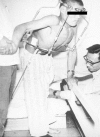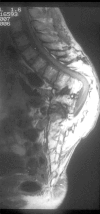20-Year-Follow up of Treatment Using Spine Osteotomy and Halo-pelvic Traction for Tuberculous Kyphosis - A Case Report -
- PMID: 20404943
- PMCID: PMC2852040
- DOI: 10.4184/asj.2009.3.1.27
20-Year-Follow up of Treatment Using Spine Osteotomy and Halo-pelvic Traction for Tuberculous Kyphosis - A Case Report -
Abstract
A 23-year-old male whose medical history included tuberculous spondylitis presented with a kyphotic deformity and incomplete paraplegia of twenty days duration. Preoperative radiographs demonstrated a T12-L4 kyphotic Cobb's angle of 100 degrees with a complete block showing on the lumbar myelogram at L4-5. The patient underwent anterior osteotomy and release. After the operation, a halo-pelvic apparatus was fit onto the patient, and distraction was begun. After distraction for 2 months, posterior osteotomy and release was performed for final correction, and distraction was maintained for another three weeks. Finally, the kyphotic deformity was corrected to a Cobb's angle of 62 degrees from T12 to L4. Supplementary anterior fusion was done, and the apparatus was removed after consolidation of the fusion mass.Even twenty years after correction of a tuberculous kyphosis, he had no neurological deterioration, and could work as a farmer using agricultural machines. Correction angle and sagittal balance were well maintained.
Keywords: Halo-pelvic traction; Spine osteotomy; Tuberculous kyphosis.
Figures





Similar articles
-
Treatment of Extreme Tuberculous Kyphosis Using Spinal Osteotomy and Halo-Pelvic Traction: A Case Report.Spine (Phila Pa 1976). 2016 Feb;41(4):E237-41. doi: 10.1097/BRS.0000000000001195. Spine (Phila Pa 1976). 2016. PMID: 26571168
-
Iatrogenic biological fracture of the cervical spine during gradual halo traction for kyphotic deformity correction: case report.BMC Musculoskelet Disord. 2020 May 21;21(1):318. doi: 10.1186/s12891-020-03350-x. BMC Musculoskelet Disord. 2020. PMID: 32438900 Free PMC article.
-
[Correction of kyphotic deformity of the cervical spine in ankylosing spondylitis using pedicle subtraction osteotomy of the seventh cervical vertebra].Acta Chir Orthop Traumatol Cech. 2014;81(5):317-22. Acta Chir Orthop Traumatol Cech. 2014. PMID: 25514339 Czech.
-
Combined percutaneous and open instrumentation for thoracolumbar kyphosis correction by two-level pedicle subtraction osteotomy in ankylosing spondylitis.Eur J Orthop Surg Traumatol. 2020 Jul;30(5):939-947. doi: 10.1007/s00590-020-02631-4. Epub 2020 Jan 24. Eur J Orthop Surg Traumatol. 2020. PMID: 31980911 Review.
-
The use of pre-operative halo traction to minimize risk for correction of severe scoliosis in a patient with Fontan circulation: a case report and review of literature.Eur Spine J. 2016 May;25 Suppl 1:245-50. doi: 10.1007/s00586-016-4538-9. Epub 2016 Mar 30. Eur Spine J. 2016. PMID: 27028615 Review.
Cited by
-
Halo-pelvic traction for severe kyphotic deformity secondary to spinal tuberculosis.Medicine (Baltimore). 2017 Jul;96(28):e7491. doi: 10.1097/MD.0000000000007491. Medicine (Baltimore). 2017. PMID: 28700493 Free PMC article.
-
Two-stage treatment for severe spinal kyphotic deformity secondary to tuberculosis: halo-pelvic traction followed by a posterior-only approach correction.BMC Musculoskelet Disord. 2022 Nov 18;23(1):991. doi: 10.1186/s12891-022-05974-7. BMC Musculoskelet Disord. 2022. PMID: 36401224 Free PMC article.
-
Effectiveness and safety of a modified (rib ends fixed under transverse process) thoracoplasty for rib hump deformity in adults with severe thoracic scoliosis: A retrospective study.Medicine (Baltimore). 2020 Sep 25;99(39):e22426. doi: 10.1097/MD.0000000000022426. Medicine (Baltimore). 2020. PMID: 32991478 Free PMC article.
-
[Clinical efficacy of short-term halo-pelvic traction combined with surgery in the treatment of severe spinal deformities].Beijing Da Xue Xue Bao Yi Xue Ban. 2020 Oct 18;52(5):875-880. doi: 10.19723/j.issn.1671-167X.2020.05.013. Beijing Da Xue Xue Bao Yi Xue Ban. 2020. PMID: 33047722 Free PMC article. Chinese.
-
Halo-pelvic traction for extreme lumbar kyphosis: 3 rare cases with a completely folded lumbar spine.Acta Orthop. 2021 Feb;92(1):9-14. doi: 10.1080/17453674.2020.1824170. Epub 2020 Sep 25. Acta Orthop. 2021. PMID: 32972285 Free PMC article. No abstract available.
References
-
- O'Brien JP, Yau AC, Smith TK, Hodgson AR. Halo pelvic traction: a preliminary report on a method of external skeletal fixation for correcting deformities and maintaining fixation of the spine. J Bone Joint Surg Br. 1971;53:217–229. - PubMed
-
- Yau AC, Hsu LC, O'Brien JP, Hodgson AR. Tuberculous kyphosis: correction with spinal osteotomy, halopelvic distraction, and anterior and posterior fusion. J Bone Joint Surg Am. 1974;56:1419–1434. - PubMed
-
- Guven O, Kumano K, Yalcin S, Karahan M, Tsuji S. A single stage posterior approach and rigid fixation for preventing kyphosis in the treatment of spinal tuberculosis. Spine (Phila Pa 1976) 1994;19:1039–1043. - PubMed
-
- Moon MS, Woo YK, Lee KS, et al. Posterior instrumentation and anterior interbody fusion for tuberculous kyphosis of dorsal and lumbar spines. Spine (Phila Pa 1976) 1995;20:1910–1916. - PubMed
-
- Laheri VJ, Badhe NP, Dewnany GT. Single stage decompression, anterior interbody fusion and posterior instrumentation for tuberculous kyphosis of the dorso-lumbar spine. Spinal Cord. 2001;39:429–436. - PubMed
LinkOut - more resources
Full Text Sources

